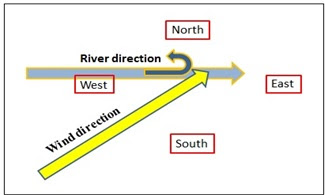Click here for the previous question
Question – 58
How can a falling meteorite or an asteroid cause the
waters of seven rivers including Sindhu to flow in the opposite direction?
Answer:
Vyasa did make an observation that there was a change
of direction of seven rivers including the Sindhu from east to west. The
mention of the south westerly wind in the context offers a clue to what could
have happened. In the event of the fall of an asteroid or a meteorite entering
the atmosphere, its trajectory and its velocity combined with the speed of the
earth influence the speed of the asteroid falling on the ground. In a recent
event of a meteor fall in July 2021, it was found to travel at 43,200 miles per
hour, causing a pressure wave which created a strong gush of wind on its path,
besides causing sonic boom (Check
here)
The jet of air dragged by a falling object, while
crossing the east flowing river, would obstruct the flow by which the water is
pushed in the opposite (western) direction. Vyasa has indeed made a very
meticulous observation of the changes in wind and water-flow.
The above figure shows the south westerly winds caused
by the falling object blocking the water flow, by which the east-flowing water
started flowing in the opposite (west) direction.
This impact felt across a vast region from the river
Sindhu to Ganga where Hastinapura is located, could not have been caused by a
single piece falling on the earth. Several pieces must have fallen from the direction
of Southwest over a larger area. Several people living near different rivers must have heard the sonic boom and the gush of air pushing the water in the opposite direction. This kind of odd observation was collected by Vyasa and compiled as a single observation that seven rivers with east flowing limbs started flowing west by the force of air.
If several asteroids are falling on the earth, it
could be the case of broken parts of a larger asteroid or a comet. The dust
thrown into the air blurs the directions. The asteroids hitting the ocean would
cause an increase in water vapor in the air that pours down as rains following
the path of the falling fragments, which is expressed as rains at the rear.
